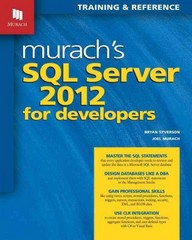Question
Top of Form Q1 Which of the following is a valid aggregate function in SQL? Check only those that apply. Question 1 options: AVG LEAST
Top of Form
Q1
Which of the following is a valid aggregate function in SQL? Check only those that apply.
Question 1 options:
|
| AVG |
|
| LEAST |
|
| COUNT |
|
| MIN |
|
| MOST |
|
| SUM |
Q2
Which of the following aggregate functions will only operate on a numeric value expression? Check only those that apply:
Question 2 options:
|
| MIN |
|
| MAX |
|
| AVG |
|
| COUNT |
|
| SUM |
Q3
When applying DISTINCT to the value being calculated in an aggregate function like COUNT, what is the effect?
SELECT COUNT(DISTINCT StreetName) FROM ADDRESSES;
Question 3 options:
|
| To count only unique values |
|
| To make a distinction between rows and columns |
|
| To add a summary COUNT for all groupings |
|
| To include duplicate values |
Q4
A query is limited to a single aggregate calculation in its SELECT clause.
Question 4 options:
|
| True |
|
| False |
Q5
The GROUP BY clause groups the rows of a result set based on one or more columns or expressions. In the example below, what will the value from COUNT(*) represent?
SELECT Department, COUNT(*) FROM EMPLOYEES GROUP BY Department;
Question 5 options:
|
| The total number of departments |
|
| The total number departments for each employee |
|
| The total number of employees |
|
| The total number of employees in each department |
Q6
Specify the correct order in which each of the six SQL clauses must be placed:
Question 6 options:
| 123456 | GROUP BY |
| 123456 | WHERE |
| 123456 | ORDER BY |
| 123456 | SELECT |
| 123456 | FROM |
| 123456 | HAVING |
Q7
The GROUP BY clause can contain more than one value (separated by commas). In the query below, what does SUM(Salary) represent?
SELECT Department, State, SUM(Salary) FROM EMPLOYEES GROUP BY Department, State;
Question 7 options:
|
| The total salary budget for the organization |
|
| The salary budget for each state |
|
| The salary budget for each department |
|
| The salary budget for each combination of department and state |
Q8
The WHERE clause and the HAVING clause can both limit rows in the result set based on logical conditions. What is the difference between the two clauses?
Question 8 options:
|
| HAVING cannot use the logical OR operator |
|
| WHERE is limited to a single condition |
|
| WHERE requires a corresponding GROUP BY |
|
| HAVING can make comparisons against aggregate functions |
Q9
Conditions comparing against non-aggregate values must be placed in the WHERE clause (never in the HAVING clause).
Question 9 options:
|
| True |
|
| False |
Q10
What is the ROLLUP operator used for in the GROUP BY clause?
Question 10 options:
|
| To save memory in query execution |
|
| To add a summary total for each grouping |
|
| To group by all values - even if they do not match WHERE clause conditions |
|
| To group based on unique values |
Bottom of Form
Step by Step Solution
There are 3 Steps involved in it
Step: 1

Get Instant Access to Expert-Tailored Solutions
See step-by-step solutions with expert insights and AI powered tools for academic success
Step: 2

Step: 3

Ace Your Homework with AI
Get the answers you need in no time with our AI-driven, step-by-step assistance
Get Started


